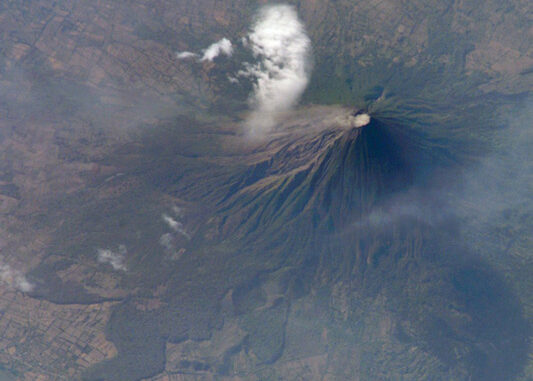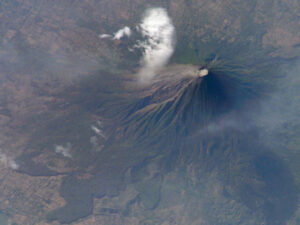

Image ISS015-E-7543 courtesy of the Image Science & Analysis Laboratory – NASA Johnson Space Center
Concepción Volcano – Isla de Ometepe – Nicaragua
You may be surprised to learn that more than 80 percent of the Earth’s surface—both above and below sea level—is of volcanic origin. Over the last few years, volcanoes in both Nicaragua—”The Land of Lakes and Volcanoes”—and El Salvador—”The Land of Volcanoes”—have erupted.
El Salvador boasts twenty-three active volcanoes. Two of the principal active volcanoes are Chaparrastique and Izalco. The Chaparrastique Volcano is located just a short distance from the city of San Miguel. Chaparrastique erupted in December 2013, causing thousands to be evacuated from their homes, and the volcano has been emitting smoke and ash in the years following that event. The Izalco Volcano is the youngest volcano in El Salvador. Known as the “Lighthouse of the Pacific,” Izalco was constantly active between 1770 and 1967. Visitors to Cerro Verde National Park can enjoy spectacular views from the rim of this volcano. The Santa Ana, or Ilamatepec Volcano, is the highest volcano in El Salvador. Its majestic façade draws visitors from all over the world. Its most recent eruption was in October of 2005.
Nicaragua has close to 50 volcanoes, nineteen of which are active. One of these, the San Cristóbal Volcano—also known as el Viejo—the highest volcano in Nicaragua, has been erupting steadily since 2001. Towering over the shores of Lake Managua, el Momotombo is among the most picturesque of the Nicaraguan volcanoes, and erupted in December 2015, for the first time in 110 years! In the Mombacho Volcano Nature Reserve near the city of Granada lies one of the most easily accessible volcanoes in Nicaragua, el Mombacho. The astounding beauty of this dormant giant draws many visitors wishing to hike and sightsee.
Both Nicaragua and El Salvador have spectacular scenery and plenty of activities for outdoor enthusiasts thanks to their impressive variety of volcanoes. Visitors can partake in everything from hiking up the slopes of a volcano to kayaking or swimming in a crater lake to “sand skiing” down the slopes that are covered in fine volcanic “sand.” Whatever the activity, it is always a thrill to be so close to something so magnificent. Follow the link to view a slideshow of volcanoes in El Salvador and Nicaragua!
View Slideshow
Explore More:
1. Investigate the origin of the word Chaparrastique. It’s quite an interesting story. Then share the story with your class.
1. Active volcanoes in El Salvador and Nicaragua are shown on the map below. Do some research to find out how many active volcanoes there are in the United States. Try to find information about the Cascade Range to learn more about both active and extinct volcanoes of the continental U.S. You can verify your findings with your science teacher and then share the information with your class.
Share What You Know:
1. Why might El Salvador’s Izalco Volcano be known as the “Lighthouse of the Pacific”?
2. The U.S. ranks third (after Indonesia and Japan) in the number of historically active volcanoes. Which U.S. state has volcanoes that have frequent, nonexplosive eruptions? Do you know the name of the volcano in the state of Washington that experienced a catastrophic eruption in May of 1980?